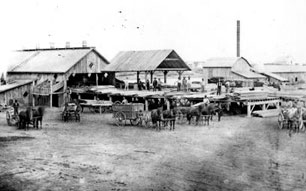|
ALEX
MAINS CAME TO THE TOWN early in 1900, and assured that the town would
have a second railway before the year’s end to make possible the
procuring of rough lumber at reasonable rates. He set up a small
planing mill on the corner of Queen Street and Spencer Avenue to
manufacture window sashes and doors.
After three successful years in his modest workshop, Alex Mains was
joined by his brother Thomas. They moved the Mains workshop and wood
yard to property south of the CNR yards and erected there a large
planing mill. Alex Mains built a fine new house beside the factory and
Thomas Mains took over the former Alex Mains house.
An illustrated price list, printed for the Mains Company in February
1903 advertised “window-sash, brackets, scroll work, screen doors and
windows, turned articles and hardwood finishing of special designs, of
as good quality and at cheaper prices than the same articles in Brandon
or Winnipeg.”
A steam engine operated the factory and the citizens were made aware of
its existence by a loud whistle, morning, noon and at six o’clock each
day.
In 1904 Alex Mains reorganized his business as a joint stock company
and offered $10,000 worth of stock at par. It was soon sold. The
company thereafter was known as “The Hartney Manufacturing Company.” It
employed, besides workmen, a full-time bookkeeper, Arthur Goad, whose
uncle, Rev. Pascoe Goad was at the time the Methodist minister in the
town.
The company seemed prosperous until 1906. That year the crops were poor
and building was at a standstill throughout the prairies. By that time,
too, most of the early pioneers’ farm buildings had been replaced by
better structures and building prospects were not bright. To add to the
company’s difficulties the dry season made it difficult to secure
sufficient water for steam power at the factory. The machinery was shut
down. At a meeting of the shareholders it was decided to discontinue
the manufacture of wooden articles and to confine the business of the
company to the sale of lumber supplies.
The Mains brothers left Hartney when the factory closed. The Mains
house beside the factory was rented by Thomas Ramsay in 1912. The
factory building was bought by William Witt and moved to his farm where
it was used as a barn. Nothing remained of the sash and door factory
but a memory.
Adapted from The Mere
Living, p. 171.
A
Sash and Door Factory
Even though the operation only lasted six years, the Mains brothers’
sash and door company was a vital aspect of local industry, ensuring
that many buildings in town and in the countryside had access to
locally crafted windows and doors. It must be assumed that many are
still in place. There are no accounts of the plant’s operations, but
surely it was very much like that described in various other accounts
of similar sash and door outfits:
“The plant was almost hidden by the great piles of lumber, up to thirty
feet high. Its location was an advantage in that the principle raw
material was made at its doorstep. A very large operation required 4
million feet of lumber and produced 50,000 doors, 90,000 windows and
18,750 blinds.
In a venetian blind-making department of the works all materials used
in this department were imported direct by the firm, including timber
for the lathes, boxwood bobbins, hurdles, and wheels for adjusting the
cords, as well as the tape cords, and paint needed. After the laths
were cut to size they were thoroughly dried and seasoned so as to avoid
all twisting and shrinking. They then passed through the lath morticing
machines. The paint was specially mixed and prepared by the paint mixer
used for the purpose. A beautiful machine was used for painting the
laths, which turned them out with the paint evenly spread on all parts.
The rails were morticed likewise by a special machine. When all the
parts were ready for putting together a beautiful adjustment was used
for the purpose. It consisted of a movable frame, which could be raised
or lowered at will on the principle of the blind.”

View of a typical lumber operation.
|





